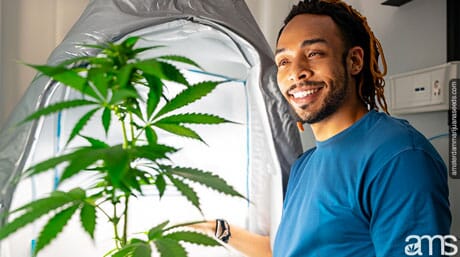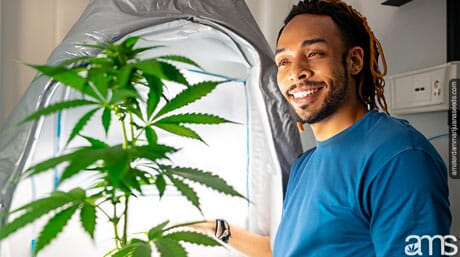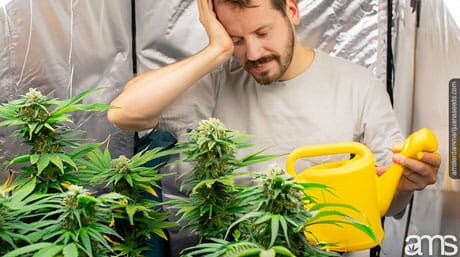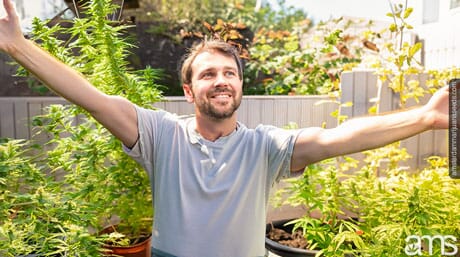marijuana growing
DIY Tips and Tricks for Homegrown Marijuana
Published
10 months agoon
By
admin
Introduction:
Growing your own marijuana has become a popular trend worldwide, offering cannabis enthusiasts a chance to cultivate their own high-quality buds right at home. Not only is it a cost-effective alternative to purchasing cannabis, but it also grants you full control over the entire cultivation process. Whether you’re a seasoned grower or a complete novice, this article will provide you with valuable DIY tips and tricks to help you embark on a successful homegrown marijuana journey. Additionally, we’ll explore the advantages of outdoor cultivation and the unique benefits it offers compared to indoor-grown cannabis.
The Appeal of Homegrown Marijuana:
The allure of homegrown marijuana lies in the ability to have complete control over the entire cultivation process, from seed to harvest. When you grow your own weed, you can choose the strains that align with your preferences, ensuring a diverse and personalized selection in your stash. Whether you’re seeking a strain with specific therapeutic properties or one that delivers a particular flavor profile, the possibilities are endless when you take the cultivation into your own hands.
Moreover, growing marijuana at home offers a cost-effective alternative to purchasing cannabis from dispensaries or dealers. While the initial investment in equipment and supplies is required, it quickly pays off as you start to harvest your own high-quality buds. Not only will you save money in the long run, but you’ll also have the satisfaction of knowing exactly how your plants were cultivated, free from any harmful pesticides or chemicals.

For both seasoned growers and beginners, the art of homegrown marijuana provides a sense of fulfillment and connection to the plant. Nurturing a cannabis plant from seedling to maturity allows you to develop a deep understanding of its growth patterns, nutrient requirements, and environmental needs. This firsthand knowledge translates into a greater appreciation for the plant’s complexities and a deeper connection to the final product.
By growing your own marijuana, you gain the freedom to experiment with different cultivation techniques, such as soil or hydroponics, and explore innovative methods like low-stress training or screen of green (SCROG). This hands-on approach empowers you to fine-tune the growing conditions, tailoring them to the specific needs of each strain and maximizing their potential for robust growth, potency, and flavor.
Getting Started with Indoor Cultivation:
When it comes to indoor cultivation, creating an optimal growing environment is key to the success of your homegrown marijuana. By setting up a well-designed grow room, you can provide the ideal conditions for your plants to thrive. Here are some essential steps to get you started on your indoor cultivation journey:
-
Choose the right strain: Selecting the right strain is crucial for indoor cultivation success. Consider factors such as the strain’s growth characteristics, flowering time, size, and resistance to pests. Indica-dominant strains, for example, tend to be shorter and more compact, making them suitable for limited vertical space.
-
Designate a dedicated space: Identify a specific area in your home that can be dedicated to your indoor garden. It could be a spare room, a closet, or even a grow tent. Ensure that the space is well-ventilated and secure, and provides adequate room for your plants to grow. This designated area will allow you to control the growing environment more effectively.

-
Set up proper ventilation: Adequate ventilation is essential for maintaining fresh air circulation and controlling temperature and humidity levels in your grow room. Use exhaust fans to remove stale air and bring in fresh air from outside. This will help prevent issues like mold and mildew and provide your plants with the proper exchange of gases.
-
Provide suitable lighting: Since indoor plants lack natural sunlight, providing artificial lighting is crucial. LED grow lights are popular among indoor growers due to their energy efficiency and ability to provide the full light spectrum necessary for all stages of plant growth. Consider the wattage and coverage area of the lights based on the size of your grow space and the number of plants you intend to cultivate.
-
Optimize temperature and humidity: Cannabis plants thrive within specific temperature and humidity ranges. Aim for temperatures between 70-85°F (21-29°C) during the day and slightly cooler temperatures at night. Additionally, maintain relative humidity levels between 40-60% during the vegetative stage and lower it to 30-40% during flowering to prevent mold and other issues. Using a hygrometer and a thermometer will help you monitor and adjust these factors accordingly.
-
Choose the right growing medium: Selecting the appropriate growing medium is crucial for indoor cultivation. Popular options include soil, soilless mixes, and hydroponics. Each medium has its own advantages and considerations. Soil is user-friendly and forgiving, while hydroponics offers faster growth rates and increased nutrient control. Consider your experience level and preferences when choosing a growing medium.
-
Provide proper nutrients: Cannabis plants require a range of nutrients to grow and thrive. You can use pre-mixed nutrient solutions designed specifically for cannabis cultivation or create your own using organic or synthetic fertilizers. Remember to follow the recommended dosage and feeding schedule for each stage of growth to ensure your plants receive the right nutrients at the right time.
-
Implement a watering schedule: Overwatering is a common mistake among novice growers. It’s important to establish a watering schedule based on the specific needs of your plants and the growing medium you’re using. Allow the soil or growing medium to dry out slightly between waterings to avoid issues like root rot. Pay attention to your plants’ visual cues, such as drooping leaves or light pots, to determine when they need watering.

By following these steps, you can lay a solid foundation for your indoor marijuana cultivation. However, it’s important to note that successful indoor growing requires continuous monitoring, adjustment, and a commitment to learning from your plants. Each strain may have specific requirements, so adapt and fine-tune your approach as needed.
The Advantages of Outdoor Cultivation:
While indoor cultivation provides precise control over the growing environment, outdoor cultivation offers unique advantages that are worth considering. Cultivating cannabis in the great outdoors allows you to harness the power of natural elements and offers an authentic connection with nature. Here are some key advantages of growing marijuana outdoors:
-
Full spectrum of natural light: One of the most significant benefits of outdoor cultivation is access to the full spectrum of natural light provided by the sun. Natural sunlight contains a diverse range of wavelengths that contribute to the plant’s growth and development. This results in cannabis plants with a richer terpene profile, enhanced flavors, and potentially higher cannabinoid levels. The intensity and quality of natural sunlight cannot be replicated by artificial lighting indoors.
-
Cost-effective and sustainable: Outdoor cultivation is generally more cost-effective compared to indoor setups. You don’t need to invest in expensive grow lights, ventilation systems, or climate control devices. Instead, you rely on the sun, rainwater, and the nutrients present in the soil. This environmentally friendly approach minimizes energy consumption and reduces your carbon footprint.
-
Expansive growth potential: Outdoor plants have the advantage of having ample space to grow and spread their roots. This results in larger plants with the potential for higher yields. Cannabis plants grown outdoors can reach impressive sizes, especially when provided with proper care and attention. The abundant space allows the plants to develop robust root systems, which can contribute to increased nutrient uptake and overall plant health.
-
Enhanced flavors and aromas: Growing cannabis outdoors exposes the plants to a variety of environmental factors that can enhance their flavors and aromas. Factors such as soil composition, regional climate, and exposure to natural elements contribute to the unique taste profiles of outdoor-grown marijuana. Many enthusiasts appreciate the earthy, natural flavors and aromas that come from outdoor cultivation.
-
Sun-kissed experience: There is something truly special about witnessing your plants basking in the warm embrace of the sun. The connection to nature and the joy of nurturing a plant under the open sky can provide a deeply satisfying experience. Additionally, spending time outdoors and engaging in the physical act of gardening can be therapeutic and offer a sense of relaxation and mindfulness.
-
Sustainability and self-sufficiency: Growing cannabis outdoors aligns with a sustainable and self-sufficient lifestyle. By relying on natural resources and reducing your dependence on commercial suppliers, you have greater control over the quality and safety of your cannabis. Additionally, the experience of growing your own marijuana from seed to harvest provides a sense of accomplishment and self-reliance.

While outdoor cultivation offers numerous advantages, it’s important to consider potential challenges as well. Factors such as climate, pests, and local regulations may impact your outdoor grow. It’s crucial to select cannabis strains that are well-suited to your specific climate and to implement proper pest prevention measures. Additionally, familiarize yourself with local laws and regulations surrounding outdoor cultivation to ensure compliance.
Experimentation and Personalization: Unleashing Your Creativity in Homegrown Marijuana
One of the most exciting aspects of homegrown marijuana is the opportunity to experiment and personalize your cultivation techniques. When you grow your own weed, you have the freedom to explore different methods and strategies that align with your preferences and goals. Here are some avenues for unleashing your creativity in homegrown marijuana:
-
Training techniques: Cannabis plants can be trained and shaped to optimize their growth and maximize yields. Techniques like topping, pruning, and low-stress training (LST) allow you to manipulate the plant’s growth patterns, control its height, and encourage the development of multiple bud sites. Each training technique offers a unique approach to shaping your plants and can result in diverse plant structures and improved light penetration.
-
Nutrient customization: Customizing nutrient regimens allows you to fine-tune the nutrient composition based on the specific needs of your plants and your desired outcomes. You can experiment with different organic or synthetic nutrient formulas, adjust nutrient ratios during different growth stages, and incorporate additives or supplements to enhance certain characteristics like terpene production or bud density. Keeping detailed notes and observing the effects of various nutrient combinations will help you refine your approach.
-
Growing mediums and substrates: While soil is a common growing medium, there are alternative options that can add another layer of experimentation. Coco coir, perlite, vermiculite, or a mix of these can be used as soilless alternatives, offering improved drainage and aeration. Hydroponic systems, such as deep water culture (DWC) or nutrient film technique (NFT), provide precise control over nutrient delivery and can result in accelerated growth rates. Exploring different growing mediums and substrates allows you to observe how they impact plant health, growth, and flavor.
-
Genetic selection and breeding: As you gain experience and confidence, you may find yourself intrigued by the possibility of creating your own unique cannabis strains through breeding. By selecting and crossing different parent plants with desirable traits, you can unlock new combinations of flavors, aromas, and effects. While breeding requires knowledge and patience, it can be a rewarding endeavor for those passionate about genetics and innovation.
-
Organic and sustainable practices: Homegrown marijuana offers an opportunity to embrace organic and sustainable cultivation practices. You can experiment with composting, natural pest control methods, and regenerative gardening techniques. By nurturing the soil microbiome and minimizing your environmental impact, you can produce cannabis that is not only high-quality but also aligns with your values and ethics.
Remember, experimentation is key to unlocking new possibilities and expanding your knowledge as a grower. Keeping a journal to document your methods, observations, and outcomes will help you track your progress and make informed decisions in future grows.

Conclusion:
Growing your own marijuana at home, whether indoors or outdoors, is a rewarding endeavor that offers cannabis enthusiasts a unique and satisfying experience. By following the DIY tips and tricks provided in this article, you can embark on a successful cultivation journey and enjoy the fruits of your labor. Whether you choose the precise control of indoor cultivation or the natural benefits of outdoor growing, the art of homegrown marijuana allows you to customize your strains, control the growing environment, and develop a deeper connection with the plant.
Embarking on your cannabis cultivation adventure opens a world of possibilities. You’ll have the opportunity to experiment with different techniques, personalize your growing methods, and unleash your creativity as a grower. As you fine-tune your skills and knowledge, you’ll discover what works best for you and your unique growing environment.
The satisfaction derived from nurturing a cannabis plant from seed to harvest is unparalleled. From selecting the perfect strains to savoring the flavors and effects of your homegrown buds, the journey is filled with joy, learning, and a sense of accomplishment. Moreover, the cost-effectiveness and self-sufficiency that come with growing your own marijuana add to the appeal of this practice.
So, whether you’re a seasoned cultivator or a novice grower, it’s time to grab your gardening tools and embark on your own cannabis cultivation adventure today. By following the guidance provided in this article and staying curious and open-minded, you’ll unlock the secrets of growing your own weed and discover the immense satisfaction and rewards it brings.
Remember, the journey of homegrown marijuana is a continuous learning process. Embrace the challenges, adapt your techniques, and enjoy the unique experience of cultivating and consuming your very own high-quality buds.
Happy growing!
Disclaimer: This content is meant for educational purposes only. It has been compiled with research from external sources. it is not meant to substitute any medical or legal advice. Please see your local laws for the legality of cannabis use.
You may like
-


Is Your Kid Smoking or Vaping Weed?
-


Press Release: PsychedelicNewsWire Named Official Media Sponsor of the 4th Annual Psychedelic Therapeutics and Drug Development Conference
-


Memorial Day’s best weed, prerolls, carts, and more 2024
-


Naps Done Right Can Make a Huge Difference
-


Michigan is selling more cannabis, but retailers are taking in less money
-


Can Marijuana Give A Break From All The Drama
marijuana growing
Boost Your Autoflowers with the Best Organic Fertilizers
Published
1 week agoon
May 9, 2024By
admin
If you are considering increasing your yield with fertilizers, you have many decisions to make. It starts with selecting one of the two principal types of cannabis fertilizers –synthetic or organic. You also need to understand the nutrients needed at different stages of cannabis growth. With this information, you can easily select the best fertilizer that fits your growing operation.
Fertilizer application for autoflowers
Auto-flowering strains are developed from the Cannabis ruderalis genetics. Cannabis strains with the auto-flowering trait depend on time and age to transition into the flowering stage. This means these plants automatically transition from the germination stage to flowering without the need for light cycle modifications. Since flowering is automatic, you would expect that these cannabis plants complete their growth cycle within a short window. However, within this period, they also rapidly absorb nutrients from the soil. These nutrients are needed for rapid cellular rearrangement, root system development, bud formations, and stem growth.
The nutrient absorption rate is high, and the plant can quickly exhaust the soil’s deposit of nutrients. This frequently happens in regions where the soil is practically poor in Nitrogen, potassium, and phosphorus. Autoflowering cannabis seeds, in many cases, need fertilizers to complete their growth cycle. Experienced cannabis farmers always have their preferred fertilizers handy as the plants start growing. In this review, we have compiled a list of the best organic fertilizers you should consider.
Why should you use organic fertilizers for autoflowers?
Both synthetic (commercially available) and organic (homemade) fertilizers are suitable for autoflowers. However, there are many reasons why you would want to consider using an organic fertilizer. Though not exclusive, here are some of the reasons to consider organic fertilizers;
1. Organic fertilizers are cheap on sale
If you are just starting on planting your first few stands of auto-flowers, you don’t want to overstretch your budget. Using organic fertilizers might help you spend less. Compared to synthetic fertilizers, the production cost for organic fertilizers is lower. The raw materials needed can be easily sourced from the environment. If you have the necessary skills, you can make these fertilizers right at home and apply them at no cost whatsoever.
2. Easily customizable
You can easily customize the nutrient content of your organic fertilizer. Synthetic fertilizers are sold in a fixed NPK ratio. Once produced, these fertilizers can only supply the component nutrients in a fixed ratio. For organic fertilizers, if you know which component supplies which nutrient, you can easily prepare fertilizer with different nutrient ratios.
3. No environmental and health hazards
Perhaps this is one of the biggest reasons many cannabis farmers prefer organic fertilizers for auto-flowers. The raw material is biodegradable, constituting no huge hazard to the environment. Since they also contain no synthetic chemicals, organic fertilizers constitute no serious health hazard. You can safely apply them without worries about getting a chemical reaction.
4. No adverse effect on harvest
You can be sure that your harvest is safe with organic fertilizers. Some synthetic fertilizers can interfere with the taste, flavor, and odor of cannabis plants. This is because residual chemicals present in these formulations can be absorbed directly into the plant’s system. With organic fertilizers, the formulation contains no residual chemicals as they are made from natural components. Your cannabis harvest is safe with its desirable features carefully preserved.
Our selection of the best organic fertilizers for auto-flowers
1. Organic superSoil
Getting it right with organic fertilizers all starts with the soil. The organic soil recipe –commonly described as ‘Supersoil’ –is one of the widely used organic growth mediums for auto-flowers. The soil is enriched with organic raw materials that are gradually decomposed over the years. The nutrients are decomposed over time into a form that the plant can easily absorb. There are various recipes and steps for mixing a SuperSoil. However, the components are always almost the same. You can modify the quantity of each component depending on the nutrient profile you need from the soil. One of the widely adopted mix ratios for autoflowers is the Ballpark recipe. Check the recipe below;
50% peat- or sphagnum-based soilless mix (provides the bulk of the medium)
10-20% mature compost (some organic nutrients + lots of microbes)
10% earthworm castings, or vermicompost (the same)
10% perlite (helps saturate the medium with O2, which is necessary for roots)
fungi/mycorrhizae/bacteria (turn raw organics into available plant food)
The fungi/mycorrhizae/bacteria component is very important. This organism plays two principal roles in Supersoils –they help decompose other components and also help the auto-flowers absorb these nutrients by binding to the plant root.
2. Bat guano
Bat poo, commonly called ‘Bat Guano,’ is a conventional organic fertilizer used in many planting operations. For thousands of years, local farmers with no access to synthetic fertilizers reportedly used bat guano. Since it works, this organic fertilizer option has survived many years of history. Today, rural farmers still use it as organically sourced fertilizer. Cannabis farmers also use Bat Guano as an organic source of Nitrogen, Phosphorus, and potassium. You can prepare bat guano in powder form or as a pre-made extract in the form of aerated tea.
Depending on the diet of the bat and its location, Bat Guano preparation can have a rich supply of both macro-and micronutrients needed by autoflowers.On harvesting the dried guano, you mix it into compost or apply it directly to the growth medium. Its rich deposit of phosphorus particularly makes it a preferred booster during the blooming period. Depending on the lay of your farm and the prevailing weather conditions, you can be creative with how you use Bat guano.
3. Manure
Manure can also serve as the right organic fertilizer for your autoflower. Primary manures are decomposed animal waste gathered from farms. Farmers who cultivate their cannabis in regions where livestock farming is a big deal prefer manual as an organic fertilizer. Since it can be readily sourced, the cost of production is very cheap. Manure offers a balanced nutrient profile for autoflowers. It also conditions the soil, making it a natural depot of plant nutrients. This deposit of nutrients makes it possible to grow autoflowers multiple times within the same cannabis planting season. For locally collected manures, composting is very important to make sure the manure does not damage the plant. Some of the most commonly prepared manure for autoflowers include;
- Chicken Manure: Manure sourced from chicken waste is high in Nitrogen. This makes a perfect option for autoflowers during the vegetative stage. Chicken manure also provides a lasting nutrient supply beyond the vegetative stage. Proper composting is needed.
- Sheep and Rabit manure: This manure is especially good for cannabis plants in the flowering stage. Although not often found in abundance, cheap rabbit manure comes naturally in an easy-to-apply pellet form.
- Composted Horses or Steers Manure: Unlike others, horses’ compost manure is produced as a cool material. This makes it easier to apply without burning the plant. They also produce a rich nutrient profile and contain beneficial organisms that can help autoflowers grow rapidly.
4. Compost tea
Though not very common, compost tea is another organic fertilizer you can consider for your autoflowers. This liquid concentrate contains soluble nutrients and microorganisms from compost materials. The key ingredients needed to make a compost team include compost. Worm casting, fish hydrolases, kelp, and molasses. The compost should have a large population of beneficial microorganisms. The worm castings are byproducts expelled from worms after digestion is completed. Kelp and molasses serve as food for fungi and bacteria that grow while the tea is brewing.
Once ready, the tea can be diluted and applied directly to the roots or sprayed on the autoflower leaves. Do not apply compost tea over an irrigation line to avoid clogging. It is also important that you apply a potent dose to a few autoflowers first and check for any adverse effects on the leaves after a few hours.
Bottom line
Growing your autoflowers with organic fertilizers is a good method of improving plant yield. The raw material needed for most organic fertilizers is locally available. You save time, energy, and resources if you choose organic fertilizers. You might also require the help of a botanist or agrochemical expert to help with any additional materials you might need. Buy autoflowering weed seeds here, great quality straight from Amsterdam
marijuana growing
“2024 Lunar Calendar Guide for Cannabis Cultivation Success”
Published
2 months agoon
March 12, 2024By
admin
Lunar Calendar for the 2024 Growing Season
Discover how the lunar phases in 2024 influence key moments in cultivation:
Germination: Perform germination during the full moon in fire signs (Aries, Leo, Sagittarius) on dates like January 25 and May 23.
Soil Preparation: Take advantage of specific dates, such as February 27 and March 24, to prepare the substrate during the waning moon in Virgo.
Transplant: Transplant during the waxing moon in water signs (Cancer, Scorpio, Pisces) on dates like March 20 and June 9.
Training and Pruning: Apply training techniques during the waxing moon in water constellations (Pisces, Cancer, Scorpio) on dates like March 11 and June 9.
Fertilization: Fertilize during the waning moon in water signs on dates like March 3 and June 29.
Harvest: Opt for harvesting in air constellations (Gemini, Libra, Aquarius) during the waxing moon or full moon on dates like September 17 and August 19.
Follow the lunar calendar and enhance your marijuana cultivation for exceptional harvests in 2024.
Cultivation of Cannabis at Home:
With the advancement of legalization in various parts of the world, there is a growing interest among individuals to cultivate their own marijuana plants at home. However, it is of utmost importance to approach this subject with responsibility and awareness, as marijuana cultivation involves legal and safety responsibilities. Additionally, proper cultivation management not only ensures compliance with regulations but also contributes to obtaining optimal plant quality, avoiding the use of chemicals that could harm its natural development and life cycle. This responsible approach not only promotes healthy cultivation but also safeguards the integrity of the environment and the well-being of those involved in this practice.
1. Legality and Regulations:
It is essential to start any cultivation project with a clear understanding of local laws and regulations. In many places, the possession and cultivation of marijuana are regulated, and even in areas where it is legal, there are limits on the number of allowed plants. Being informed about local regulations is crucial to avoid legal issues.
2. Seed Selection:
Choosing the right seeds is a crucial step. There are varieties with different levels of THC and CBD, as well as autoflowering options that simplify the process. Researching and selecting seeds that suit your needs and skills are key to successful cultivation.
3. Controlled Environment:
Creating a controlled environment is essential for the healthy growth of plants. Marijuana requires specific conditions of light, temperature, and humidity to thrive. Installing a suitable lighting system and regulating the climate are important considerations.
4. Nutrients and Irrigation:
Providing the right nutrients in the correct amounts is vital for plant development. Novice cultivators often underestimate the importance of a well-balanced nutrient program. Additionally, proper irrigation, avoiding both excess and scarcity, is fundamental to prevent issues such as mold and root rot.
5. Security and Discretion:
Maintaining security and discretion is crucial, especially if you live in an area where marijuana cultivation is subject to legal restrictions. Ensure that your cultivation space is protected and out of reach of unauthorized individuals.
100% Natural Cultivation:
With the appropriate knowledge and a consistent commitment to best practices, home cultivators can reap the rewards of a successful cultivation, respecting both laws and safety standards. It is crucial to consider the natural cycles of the moon, leveraging its benefits for plant development. Additionally, exploring various techniques that promote the natural growth of the plant is advisable, ensuring exceptional quality. It is worth noting that this process ensures a cultivation free of chemicals, which is essential to preserve plant quality and, consequently, the safety of human consumption.
marijuana growing
44K Job Opportunities by 2030
Published
3 months agoon
February 12, 2024By
admin
By: Juan Sebastian Chaves Gil
With sales exceeding $70 million during the II National Cannabis and Hemp Summit in Cali, it is clear that the medicinal and industrial sector of this crop is driving the country’s economy. Entrepreneurs, experts, and representatives were integral parts of this event, whose purpose is to demystify misconceptions about cannabis and support entrepreneurs in their formalization process.
Pedro Andrés Bravo, Secretary of Economic Development and Competitiveness of Valle, emphasized that this sector promotes inclusion and projects the creation of more than 44 thousand jobs by the year 2030. For this reason, Valle del Cauca leads the Business Justification and Diversification Index, pioneering in demonstrating the potential of this market.
The National Cannabis and Hemp Summit, led by the Government of Valle del Cauca, has become the most relevant event since the approval of the law on medicinal and industrial cannabis in the country.
According to Agronegocios, Valle del Cauca ranks fifth in national cannabis production, representing 2% in the year 2021.
Valle del Cauca stands out as the first department with a Medicinal and Industrial Cannabis production chain, coordinating the activities of 220 producers.
David Pérez, director of Mercannábico, the first Amazon-type marketplace for the cannabis industry in Colombia, emphasized the importance of these events to counteract the misinformation that has affected the sector. He highlighted that cannabis needs everyone to connect and that Colombia perceives it not as a problem but as a solution to medical ailments.
Estefanía Patiño Valencia, advisor to the Office of Social Management of Valle, pointed out that the summit managed to bring together the Ministries of Justice and Health, ICA, and Invima. All requests for the development of the industry were processed, and a departmental commitment was established with elected mayors, deputies, and councilors to work together for this sector.

Is Your Kid Smoking or Vaping Weed?

Press Release: PsychedelicNewsWire Named Official Media Sponsor of the 4th Annual Psychedelic Therapeutics and Drug Development Conference

Memorial Day’s best weed, prerolls, carts, and more 2024

Naps Done Right Can Make a Huge Difference

Michigan is selling more cannabis, but retailers are taking in less money

Can Marijuana Give A Break From All The Drama

Consumer Spending Validates Marijuana Rescheduling

How Did Hidden Leaf Cannabis Become the Leader of the Ontario Marijuana Market?

Are You Bored So You Smoke Weed or Do You Smoke Marijuana and Get Bored?

Cannabis Rescheduling Takes The Next Steps

Distressed Cannabis Business Takeaways – Canna Law Blog™

United States: Alex Malyshev And Melinda Fellner Discuss The Intersection Of Tax And Cannabis In New Video Series – Part VI: Licensing (Video)

Drug Testing for Marijuana – The Joint Blog

What you Need to Know

Cannabis, alcohol firm SNDL loses CA$372.4 million in 2022

NCIA Write About Their Equity Scholarship Program

City Of Oakland Issues RFP For Employee Training Programs

It has been a wild news week – here’s how CBD and weed can help you relax

A new April 20 cannabis contest includes a $40,000 purse

UArizona launches online cannabis compliance online course
Trending
-

 Cannabis News1 year ago
Cannabis News1 year agoDistressed Cannabis Business Takeaways – Canna Law Blog™
-

 One-Hit Wonders1 year ago
One-Hit Wonders1 year agoUnited States: Alex Malyshev And Melinda Fellner Discuss The Intersection Of Tax And Cannabis In New Video Series – Part VI: Licensing (Video)
-

 drug testing5 months ago
drug testing5 months agoDrug Testing for Marijuana – The Joint Blog
-

 Cannabis 1011 year ago
Cannabis 1011 year agoWhat you Need to Know
-

 Marijuana Business Daily1 year ago
Marijuana Business Daily1 year agoCannabis, alcohol firm SNDL loses CA$372.4 million in 2022
-

 Education1 year ago
Education1 year agoNCIA Write About Their Equity Scholarship Program
-

 Education1 year ago
Education1 year agoCity Of Oakland Issues RFP For Employee Training Programs
-

 Cannabis1 year ago
Cannabis1 year agoIt has been a wild news week – here’s how CBD and weed can help you relax



